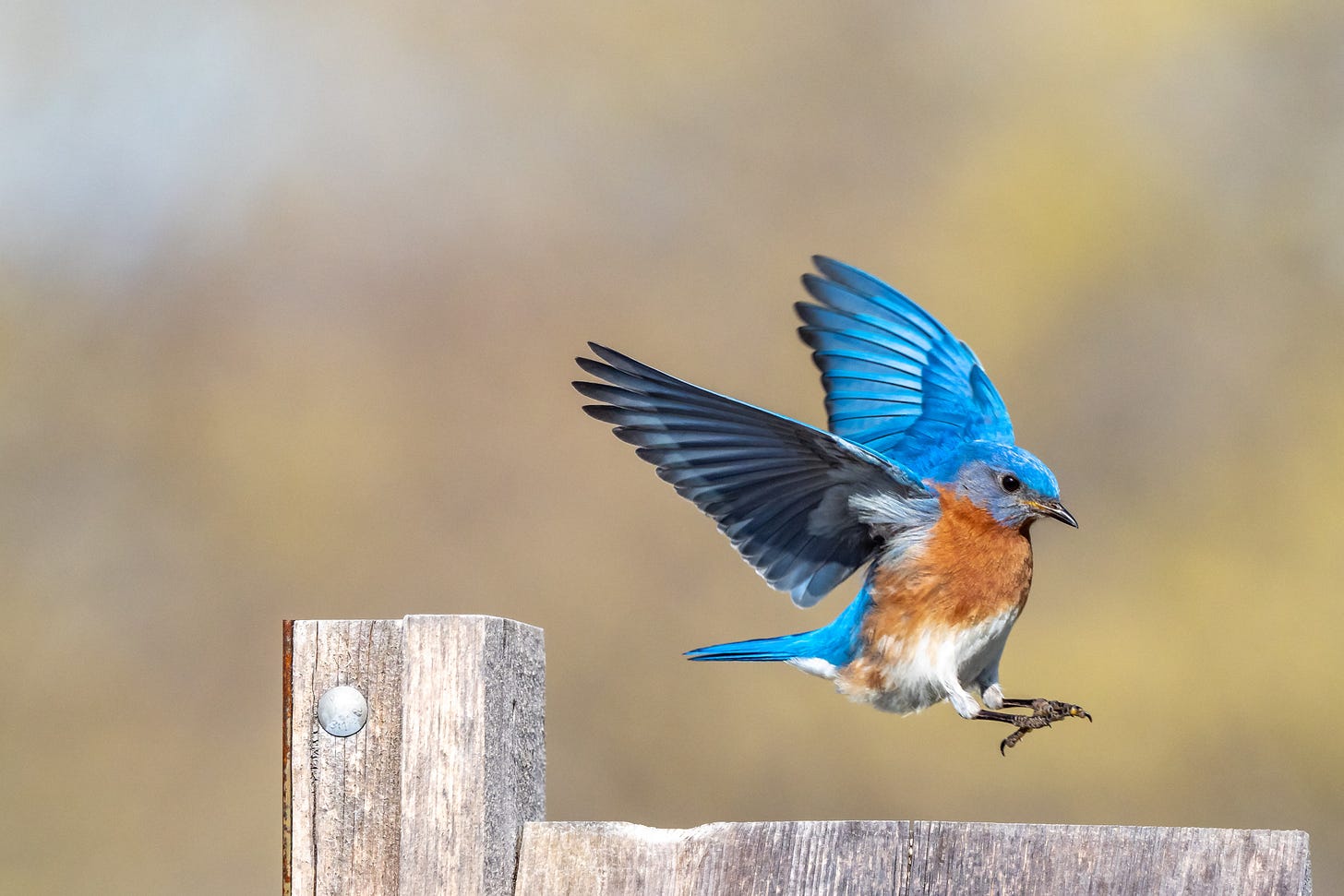Welcome to Thursday Things! If you enjoy this edition, please click the heart icon in the heading or at the end of the post to let me know. You can also comment by clicking the dialogue bubble next to the heart.
“It’s all done with nanoscale structures.” Photo by Ruben Ortega on Unsplash
How blue, how beautiful. How Animals Color Themselves With Nanoscale Structures
Many of the colors seen in nature, particularly in the plant kingdom, are produced by pigments, which reflect a portion of the light spectrum while absorbing the rest. … To make the richer rainbow of colors they need for decorating and disguising themselves, courting mates and warding off predators, animals can often obtain the needed pigments from their diet. Birds’ bright reds and yellows, for instance, mostly come from carotenoid pigments in their food.
The blue end of the spectrum, however, represents a different challenge because few blue pigments are available to eat in nature. Yet blue jays, neon tetras, poison dart frogs and many other animals found a solution that doesn’t rely on pigments, evolving optical tricks to make blues (and some greens) a different way. They make what are called structural colors.
Structural colors act like filters that allow only some wavelengths to pass through. Their specific photonic mechanisms vary from species to species, but they work because nanometer-scale structures in their materials are comparable to wavelengths of light. The structures diffract colors of light differently and set up interference effects.
The color blue is an endless source of fascination. We’ve covered blue pigments before here at Thursday Things. In ancient times, only the Egyptians were successful in creating a blue dye. In fact, many ancient cultures didn’t perceive blue as a distinct color or even have a word for it.
Now it seems that nature has the same problem coming up with blue pigments. If you're a frog or a bird or fish who wants to be blue, what do you do? You use nanotechnology!
“It’s about having multiple tiny structures that scatter light, and then having those scattered waves interact — that interaction will reinforce some colors and eliminate the others,” explained Richard Prum, an expert on bird-feather coloration at Yale University.
Read the whole thing for a fascinating dive into the world of blue.
“Bluebird. I eat bugs and do advanced optical physics.” Photo by Patrice Bouchard on Unsplash
How to wipe metadata from any file. You’d be surprised what kind of information travels along with your digital files…
Everything you upload to the internet has metadata attached to it. This is everything related to a file that’s not the content itself—format, what program it came from, its creation date, and sometimes even the name of its author.
It gets even trickier with images, as these files use a standard called exchangeable image format, or EXIF. When you use a phone or tablet to capture photos or video, it will (by default) embed information like the make and model of the device that generated the file, along with the exact GPS location where it was created. (You can opt out of these settings, though.) When you use a digital camera, this bundle of information will also include technical data like ISO speed or the aperture settings you used when you took the photo.
If sharing that potentially personal information makes you feel queasy, you’re not alone. The good news is you can delete that data before you share any file.
You wash your hands. You might want to scrub your metadata too.
Finally! A cure for the hiccups. Drinking straw device is instant cure for hiccups, say scientists
From holding your breath to having a friend shout “boo!”, there is no shortage of alleged cures for hiccups. Now scientists say they have found a better solution: a drinking straw device.
Called “the forced inspiratory suction and swallow tool” (FISST), and patented as HiccAway, the $14 (£10) plastic device is a rigid L-shaped straw that has a mouthpiece at one end and an adjustable cap with a pressure valve, in the form of a small hole, at the other. Hiccuping people place the device into a glass of water and use it to sip.
“HiccAway” That is sheer marketing genius. Although is it really better than standing on your head while gargling peanut butter? Well, the HiccAway reportedly cured hiccups in 92% of cases.
Here is the science article behind the invention: Evaluation of the Forced Inspiratory Suction and Swallow Tool to Stop Hiccups
I love their statement of the problem:
Home remedies to relieve transient hiccups, such as breath holding, recycled breathing in a paper bag, and drinking water from the far side of a glass, are plagued by unclear instructions, inconsistent performance, and poor effectiveness. There is a need for a simple and effective method to stop hiccups. The forced inspiratory suction and swallow tool (FISST) has a low-cost design and straightforward mode of action that stimulates the phrenic and vagus nerves by inducing diaphragmatic contraction and epiglottis closure, respectively.
And if you’re one of the 8 percent with hiccups whom the HiccAway does not cure, then all I can say is … BOO!
Did I scare you? Did that work?
UFO history. Unidentified flying objects have been in the news lately. But as Cracked shows in this article, America’s First UFO Sighting Was Way Earlier Than You Think
Way back in 1639, in fact, John Winthrop, lawyer, Puritan, and Governor of the Massachusetts Bay Colony, jotted down in his diary a report of the first UFO sighting by a European settler in what would soon be known as the United States of America.
I wonder if Governor Winthrop then started a Puritan X-Files in Massachusetts Bay Colony that we never heard about?
Thank you for reading Thursday Things. Please click the hearts, comment, and use the share button to send this issue to a friend who might enjoy it. See you next Thursday!




